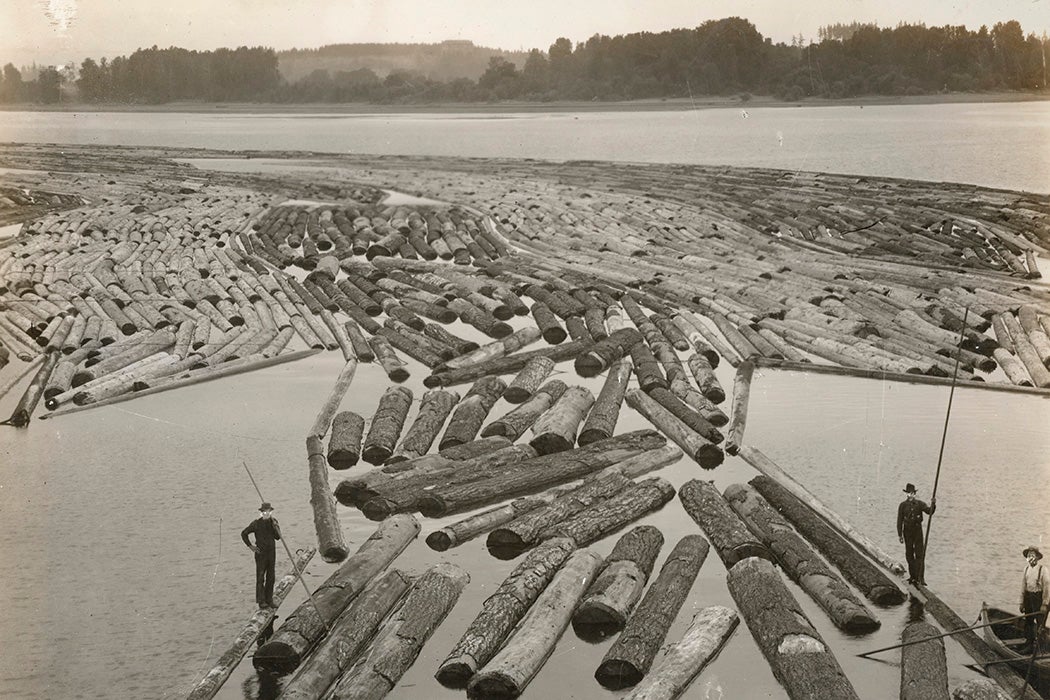The word “lumberjack” typically conjures an image of a hirsute, tall, plaid-wearing white man (although there were Black lumberjacks and even Asian-American ones). But the image of a man felling a tree is—for the most part—a relic or a thing of sport.
Yet, the lumber industry was once a major employer, and Michigan was its biggest domestic producer in the 1800s. The state’s dominance was thanks to the abundance of trees there and, more importantly, the abundance of water, essential for transporting logs.
Prior to this, logging and lumberjacking were small scale operations, “mere adjuncts” of agriculture, writes Thomas R. Cox in an article about lumbering in Pennsylvania. It wasn’t until the development of “new methods of forest exploitation and lumber manufacturing” that mass-production enterprises for the “industrializing, modernizing nation” sprung up.
“For much of the lumber era, the major form of log transportation in the Lake States was river driving,” explains Rand E. Rohe in an article published in The Great Lakes Review, and the men who steered loose timber down rivers—like cowboys wrangling cattle—were known as “log drivers.”
Log driving was no easy profession, and making such navigation possible was a formidable challenge. To aid the passage of lumber on the water, timber firms built dams and sluices, blasted out rocks, cut overhanging branches, and cleared driftwood. “Log slides”—literally, slides for logs—were built along hillslopes to take advantage of gravity to transport timber to the water’s edge. From there, logs accumulated at a landing (also called a “spar tree site,” or “rollway”). Logs then had to be manually “marked” with a timber firm’s details—sort of like a cattle-brand—before they made their way downstream. Typically, this happened with a “stamp hammer” details Elizabeth M. Bachmann in an article about Minnesota log marks, with the hammer weighing about four or five pounds. Since timber companies shared rivers and waterways, altering these marks was a punishable offense.
From there, these free-floating logs were “driven” by log drivers along the river. Unlike timber rafters—who nearly chained together multiple logs to make rafts, which they themselves floated downstream—for log drivers, the aim was to keep the lumber moving, following along where needed and heroically pulling out logs that held up traffic.
“It was a more labor-efficient means of getting out logs than was rafting and yielded them in numbers that raftsmen could never hope to match,” notes Cox. (It’s perhaps worthwhile noting that timber rafting still exists today.)
There were no bounds to danger, however. Since log driving was largely carried out in the spring, when rivers thawed (and after a long winter harvest of wood), accidents in treacherous currents were frequent. In an as-told-to article titled “The Life of a Lumberman” published in The Wisconsin Magazine of History, lumberman John E. Nelligan recounts an 1878 incident during which he saw a colleague carried into the current and down the Oconto Falls along with the logs. Miraculously, the fellow survived.
For all their work, log drivers “received two and one-half dollars and four meals per day,” according to Nelligan. That’s about 76 in today’s dollars. By comparison, he notes, a farm worker would’ve earned “sixteen or eighteen dollars per month.”
All the while, the US rail network was under enormous expansion. Between 1866 and 1916, it had grown to 254,000 miles from 35,000. With better-connected roads and railways, rivers were no longer the best way to transport wood, and log driving became obsolete. In parts of the US, log driving endured under the guise of “tradition.” Eventually, environmental concerns about log-related impacts pushed a law through the Maine legislature that ended all log driving in Maine by October 1976. The last one reportedly took place in Maine on the Kennebec River in 1976.
Weekly Newsletter
The end of log drives did not end the logging industry altogether, of course, though it did play a part in diminishing it, along with recessions and other economic factors. By the early 1980s, the demand for lumber in the US had fallen by 30 per cent. In an article in Monthly Labor Review, Mary Beth W. Scaggs notes that “the lumber and wood products industry [was] weakened by [the] decreased demand for new housing during the 1980 and 1981-82 recessions.” More recently, the movement to green the economy has led to calls to move away altogether from lumber as a construction material and toward more environmentally sustainable materials.
Even as that happens, though, the romance of the log-driving era endures. Birling contests still draw both brave competitors and spectators and both Canadians and Americans lay claim to that most iconic of all lumberjacks, Mr. Paul Bunyan. Above all, the log driver lives on in aesthetic—beards, flannels, jeans, and work boots—jointly signs of the “lumbersexual,” whose best hope for handling an ax is at trendy bars in the hipper precincts of New York City.
Support JSTOR Daily! Join our membership program on Patreon today.







